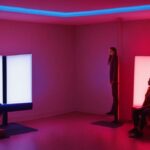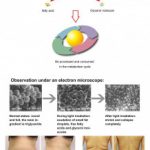Light therapy is a popular method that has grown in popularity over the years for treating different conditions such as depression, skin disorders, and seasonal affective disorder. Despite its popularity, many people still question whether or not this method of therapy is effective or not. This topic seeks to explore and answer the question, does light therapy actually work?
Contents
The Science Behind Light Therapy
Light therapy, also known as phototherapy, involves the use of specific wavelengths of light to treat various conditions. The therapy has been around since the early 1900s, and it has been used to treat seasonal affective disorder (SAD), sleep disorders, and skin conditions such as psoriasis and acne.
Research has shown that light therapy works by affecting the body’s circadian rhythm, which is the internal clock that regulates sleep and wake cycles. The therapy also stimulates the production of serotonin and dopamine, which are neurotransmitters that help regulate mood and emotions.
How Does Light Therapy Work?
Light therapy works by exposing the skin to specific wavelengths of light. The light penetrates the skin and is absorbed by the cells, which then trigger various physiological responses in the body.
The therapy is typically done using a light therapy box or lamp, which emits bright light that mimics natural sunlight. The light is usually white or blue, and it is delivered at a specific intensity and duration.
What Conditions Can Light Therapy Treat?
Light therapy has been shown to be effective in treating a variety of conditions, including:
- Seasonal affective disorder (SAD)
- Depression
- Sleep disorders
- Jet lag
- Skin conditions such as psoriasis and eczema
- Acne
- Chronic pain
- Dementia
The Effectiveness of Light Therapy
While light therapy has been shown to be effective in treating various conditions, it is important to note that the therapy may not work for everyone. Some people may not respond to the therapy, while others may experience side effects such as headaches, eye strain, and nausea.
What Does the Research Say?
The research on light therapy has been mixed, with some studies showing that it is effective in treating various conditions, while others have found no significant effects.
For example, a 2015 study published in the Journal of Clinical Psychiatry found that light therapy was effective in treating depression, with 50% of the participants experiencing remission after four weeks of treatment. However, a 2019 study published in the Journal of Affective Disorders found that light therapy was not effective in treating bipolar depression.
Factors That Affect the Effectiveness of Light Therapy
Several factors can affect the effectiveness of light therapy, including:
- The intensity and duration of the light
- The timing of the light exposure
- The type of light used (e.g. white or blue light)
- The individual’s age and health status
Who Should Avoid Light Therapy?
While light therapy is generally considered safe, there are some people who should avoid the therapy, including:
- Individuals with bipolar disorder or other mood disorders
- Individuals with eye conditions such as macular degeneration or cataracts
- Individuals taking medications that increase sensitivity to light
How to Use Light Therapy
If you are considering using light therapy, it is important to talk to your healthcare provider to determine if the therapy is right for you. Your healthcare provider can also help you determine the best type of light therapy and the appropriate duration and intensity of the therapy.
Tips for Using Light Therapy
Here are some tips for using light therapy:
- Use a light therapy box or lamp that emits white or blue light.
- Sit in front of the light therapy box or lamp for 20-30 minutes per day.
- Use the therapy in the morning to help regulate your sleep and wake cycle.
- Keep the light therapy box or lamp at a distance of 16-24 inches from your face.
- Do not look directly at the light.
FAQs: Does Light Therapy Actually Work?
What is light therapy?
Light therapy, also known as phototherapy, is a treatment that involves the exposure to artificial light to relieve various conditions such as depression, skin problems, and sleep disorders. It’s a non-invasive method of treating certain conditions and improving overall quality of life.
Different types of light therapy provide different effects on the body. For instance, bright light therapy involves exposure to intense artificial light which helps to stimulate wakefulness, and reset the body’s circadian rhythm, thereby improving sleep. On the other hand, red light therapy, which involves exposure to low-level red light, penetrates deep into the skin to reduce inflammation and promote tissue repair.
What conditions can be treated with light therapy?
There is a range of conditions that may benefit from light therapy, including seasonal affective disorder, insomnia, jet lag, acne, psoriasis, and eczema, among others. However, it’s essential to note that not all conditions will benefit from light therapy, and seeking advice from a healthcare professional before starting on this treatment is crucial.
Does light therapy really work?
As with any form of treatment, the efficacy of light therapy varies depending on the specific condition being treated. However, various studies and research have shown that light therapy can be effective in relieving symptoms of various conditions such as depression, seasonal affective disorder, and sleep disorders. In some cases, light therapy is considered the first line of treatment for such conditions.
Are there any side effects of light therapy?
While light therapy is generally considered safe, it does have some side effects, such as eye strain, headaches, and feelings of agitation. These side effects are usually mild and tend to go away after treatment. However, in rare cases, light therapy can worsen certain conditions such as bipolar disorder, and prolonged exposure to UV light can increase the risk of skin cancer.
How long does light therapy take to work?
The length of time required to see the benefits of light therapy varies depending on the specific condition being treated. For instance, for seasonal affective disorder, symptoms may start to improve within a few days of starting light therapy, while acne may take several weeks to show improvement. In general, it’s essential to follow the recommended course of treatment as determined by a healthcare professional for optimal results.
Can light therapy be done at home?
Light therapy can be done at home using a specialized lightbox or other light-emitting devices. However, it’s crucial to consult with a healthcare professional before starting on light therapy at home. They can help determine the right type of light therapy device for the specific condition being treated and provide guidance on the optimal duration and timing of the treatment.







